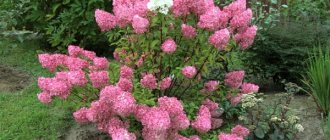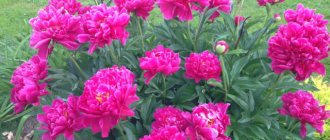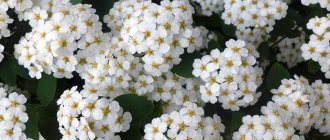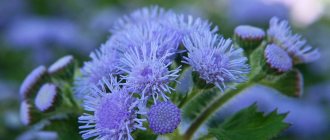Origin of the name and place of distribution
The broadbell received its name due to the appearance of the flowers, which really look like large bells. It is known that naming comes from the ancient Greek language. The only representative of the genus is called Platycodon grandiflorus, or large-flowered bellflower, sometimes confused with broadleaf bellflower, which, of course, cannot be done, since these are completely different plants.
The bushes grow in China, Korea and Japan, and are sometimes found in the Far East and Eastern Siberia. Platycodon has been cultivated since 1872, but the peak of the plant's popularity occurred at the beginning of the 20th century.
Description
Platycodon grandiflora has a well-developed root system, the shoots of the flower are quite tall, they are abundantly covered with leaves. The height of the stems varies from 20 to 80 cm. In the lower part the foliage is collected in a rosette. Platycodon greenery is characterized by a bluish tint. The inflorescences consist of several wide flowers, the number of which can reach 5 pieces. If you look closely at the petals, you can see pronounced veins.
The wide-open flowers are about 8 cm in diameter in many varieties, including the white-flowered Platycodon grandiflora Aster. Plants with blue petals have thin dark mesh veins. Some forms are dark purple in color. The buds are shaped like bells and lanterns. Flowering begins in mid-July and lasts 2 months. According to reviews from gardeners, platycodon goes well with crops such as gypsophila, low-growing phlox and tall bell.
PLATICODON (WIDEBELL) “SHELL PINK”
Platycodon is a true perennial, and if you manage to find a suitable place for it in the garden, it can decorate the flower garden for many years. In addition, it has its own character and temperament: it is a phlegmatic plant. In spring it wakes up late, 3 weeks later than most perennials. So late that you will have time to think that the plant died in winter. Then you discover the charming new shoots of a well-rested plant. Then Platycodon grows as if nothing had happened, forming a beautiful, durable bush with bluish smooth leaves, and blooms in July. At the same time, it looks charming already in buds, which, in accordance with its leisurely nature, do not open for a long time. But the buds are no less beautiful than the flowers: large, like Chinese lanterns. An adult multi-stemmed bush blooms for at least two months. Platycodon makes us happy all September: it no longer blooms, but the bush shines even brighter than the blooming one. At this time, the leaves first acquire a lemon and then a yellow and purple color and last until frost.
Platycodon "Shell pink" is a perennial herbaceous plant with numerous stems, each of which can grow from 50 to 80 cm. The inflorescences resemble wide-open cups with five adhesive corollas. The color of the bells is pink. Diameter up to 8cm. Platycodon blooms for about two months, starting in mid-June.
The plant is planted in a well-lit place with fairly fertile soil. With partial shading, Platycodon grows well, but the stems will be weaker, and a garter may be required; the flowering period will be delayed. Platycodon is planted immediately in a permanent place, since the structure of the root system does not allow replanting without damaging the plant. For the same reason, bushes cannot be divided.
Water as the soil dries out. Mature plants will survive dry periods without damage. Long-term stagnation of melt water and close standing groundwater are destructive. The root system of the plant consists of succulent, fleshy, deep-lying roots, so good drainage of the planting site is necessary. It is also worth improving the breathability of too dense soils by adding gravel or coarse sand. Plants respond well to regular mulching. Removing spent flowers prolongs the flowering period. Platycodon has no diseases or pests; as a rule, in good conditions, plants do not suffer from anything. Before wintering, the plant must be completely cut off. Platycodon overwinters quite reliably, suffering only in winters with frequent alternations of thaws to bare ground and frosts. In case of snowless winter, cover the replanting site.
Pairs perfectly with phlox, daylilies, peonies, irises, asters, sedums, and cereals. They look great against the background of herbaceous or woody plants with silver, dark green or purple foliage; these can be conifers, bladderworts, barberries, etc.
Varieties
There are several varieties of the plant. The color of the petals directly depends on the variety of Platycodon and varies from pink and white to pale blue. Sometimes dark veins appear on the flowers. All varieties are similar in appearance, but have slight differences in the type of petals and their color, the size of the bush and bells.
If we talk about flowers of the Astra type, we can select Platycodon grandiflora Astra Pink. Its petals are painted in a delicate pink shade. Platycodon Astra Blue is characterized by blue flowers. There are varieties with white petals. The peculiarity of the Astra type plant is that its bushes are low-growing. The Double variety is very popular. These flowers have petals arranged in two rows. The veins are best expressed in the plant variety Platycodon Pink Florist. The bloody veins are clearly visible against the soft pink background. The large-flowered Platycodon Fuji Blue, on the contrary, has only one row of petals, and the color of the flowers is very delicate. There are several more varieties of crops with which you can decorate your site.
- Album. The shoots of this variety grow up to 60-80 cm, white flowers reach 8 cm in diameter. There are blue veins on the surface of the petals. According to reviews, flowering lasts for quite a long time: from June to August.
- Shelp Pink is a plant 80 cm high. Large flowers are light pink in color.
- Marisil Blue is a low bush whose shoots grow up to 35 cm. The blue petals have a lavender tint.
- Fairy Snow is another variety of tall Platycodon. The length of the shoots reaches 80 cm. According to reviews, delicate single flowers look very impressive; they can be painted white or light lilac.
- Epoema is the shortest variety of broadbell, the height of which does not exceed 20 cm. The flowers are colored blue-violet. Experienced gardeners advise growing the crop in rock gardens and rock gardens.
- Snowflakes is a bush that reaches a height of only half a meter. The flowers are semi-double, white, and attract attention.
- Mather of Pearl. The shoots grow up to 60 cm. There are pale pink flowers on the stems.
There is a flower called Codonopsis Ussuri, which is very similar to Platycodon, moreover, it is closely related to the broadbell. However, codonopsis flowers have a strong aroma that some people may find unpleasant. For this reason, it is not very popular among domestic gardeners.
Description and varieties
A plant with completely bare bluish stems, having a height of 40 to 120 cm. The rhizome is white, fleshy, similar in shape to a radish. Diamond-shaped leaves with an elongated pointed apex and serrated edges are arranged alternately. The flowers are most often single, but occasionally they are collected in small inflorescences of 2-10 large flowers, which are located on the tops of the shoots. The flowers have a classic bell-shaped shape and reach 8 cm in diameter; they can be simple or double. Wild Platycodon is always blue in color. But breeders have developed varieties of white and pink flowers. Flowering occurs in midsummer, in July and August. The fruit is an ovoid capsule consisting of 5 shiny dark teeth about 2 mm long.
There are dwarf and tall varieties; they can also differ in flower shape and color. All of them are extremely decorative. A striking feature of Platycodon is the swelling of the bud to a spherical state before opening. The buds become like bright colored lanterns.
Platycode Album
Let's consider the most popular and sought-after varieties.
- Album . A powerful bush up to 0.8 m high with luxurious large white flowers, on the petals of which blue veins sometimes clearly appear.
- Platycodon Astra Pink . A small plant no more than 20-25 cm in height with very large star-shaped single flowers of pale pink color.
- Astra Blue . Huge blue flowers with bright blue veins along the petals.
- Double _ Another variety of the Astra variety has a double row of petals.
- White . Compact small bush about 20 cm high with star-shaped delicate bright white flowers.
- Shell Pink . The variety is quite tall - up to 0.8 m, the flowers are light pink.
- Fairy Snow . A bush up to 0.8 m tall with white, slightly lilac flowers, covered with a network of graceful purple veins.
- Pink Florist . Bright pink flowers with almost bloody veins.
- Marisil Blue . Bushes of medium height (up to 35 cm) with very beautiful lavender-blue flowers.
- Pleno Alba . A variety that has snow-white double flowers with beautiful stamens.
Landing
The plant is usually planted in open ground at the end of spring, when the temperature at night no longer drops to about. According to reviews, you need to take care of comfortable conditions for culture on the site. It should be well lit, although in some cases the crop can be planted in partial shade. Loose soil that contains the necessary set of nutrients is suitable for growing platycodon. The soil should be drained first. Use loam with added sand as a substrate; the acidity should be neutral. Gardeners give this advice in their reviews.
Please note that the roots of Platycodon grandiflora grow not horizontally, but vertically. For this reason, it is better to plant the crop in areas where there is no groundwater. Since the rhizome is tender, it is not customary to replant the plant, which means that the bushes stay in one place for 10 years or longer.
Before planting flowers in open ground, dig up the soil and add fertilizer to it. You will need a tablespoon of complex mineral fertilizer, as well as half a glass of tree ash. The size of the hole should be slightly larger than the dimensions of the pots with seedlings. The distance between the holes should be 30 centimeters or more. Gardeners advise pre-watering the soil, after which you can place the crop in the holes and completely cover them with soil.
Possible problems
Platycodons are disease resistant. The greatest danger for them is excessive watering, which causes rot. When affected areas are detected, simple measures are often sufficient: reducing watering, loosening the soil. Damaged parts of the plant are removed during transplantation. An emergency measure may be a transplant. If rot continues to spread despite the measures taken, then it is necessary to use fungicides for disinfection.
It is not for nothing that flowers are used in oriental cooking. Their taste attracts various rodents. To expel mice and moles from the area, you can use various rattles and fill the holes with water. If platycodon requires replanting, it is best to do it in winter, when the plant is dormant.
Platycodon is easily pollinated. Therefore, if you independently prepare seeds for further planting, you must carefully place other plants nearby to avoid losing the characteristics of the variety in the future.
Where can you use a bell?
In landscape design, plants can be used for various purposes. They allow you to make bright accent spots in clearings and lawns, in flower beds. Bluebells are often used as partners for roses and other plants. Flowers look great in compositions that involve continuous flowering. Plants can not only be used in combination with other types of flowers, but also used alone. Platycodon are also used in bouquets.
Toraj-namul
The prepared root, from which the bitterness has been removed, is cut into strips. To it add a little finely chopped green onion, garlic and half a spoon of ginger, sesame oil. The mixture is fried in a frying pan, 100 ml of water is added and simmered until completely evaporated. After this, add a little more sesame oil and salt, and the salad is ready.
Currently reading:
- How to grow Chinese cabbage in open ground
- Planting to decorate the site with three types of coniferous trees
- Choosing cucumbers for open ground according to your preferences
- Exquisite juncus (rumen) spiral-shaped in the interior
Share the news on social networks
About the author: Lyudmila Vasilievna Nosikova
Agronomist of the state agricultural enterprise "Garovskoe" of the Khabarovsk region of the Khabarovsk Territory.
Watering
Within 15 days after planting the crop in open ground, the plants must be watered daily, according to reviews from gardeners. After this period, this procedure is carried out as necessary. As an adult, Platycodon grandiflora can tolerate heat and dryness. During watering, you need to loosen the soil and get rid of weeds. If the place where the crop grows is covered with mulch, then the above procedures can not be carried out too often.
Planting and care
When planting platycodon, planting and caring for which is not particularly difficult, it is necessary to take into account some requirements.
This is a flower that will bloom profusely and brightly in well-lit areas. It can also tolerate partial shade, but then its stems will stretch in height and may need support. Constant burning sun rays are also not very suitable for the plant. The ideal option is mosaic lighting.
This bell is very hardy, able to winter in open ground and lives quite a long time. When grown indoors, it requires a period of winter dormancy in order for it to bloom profusely next year.
Platycodon in the garden
Platycodon's soil requirements are not very high, which makes its cultivation much easier. It is suitable for loose, light, loamy soils with a rich set of nutrients. The roots of the flower are very fragile and delicate; stagnation of moisture, which can cause rotting, is extremely harmful to them. Watering is necessary as the soil dries out. To prevent water stagnation at the roots, it is necessary to regularly loosen and mulch the soil.
During the growing season, it is recommended to feed the plants with complex mineral fertilizers once a week.
Growing from seeds
Platycodon grandiflora Astra, as well as other varieties of this crop, can be propagated in several ways. The most reliable of them, according to gardeners, is seed. In early or mid-spring, material is sown into the soil for flowering plants. The soil mixture is prepared from sand, peat soil and humus. Sowing is done to a depth of 3-4 mm. It is recommended to keep the crops at room temperature. After 15-20 days, shoots will appear, after which the temperature is gradually reduced to 16 degrees. The seedlings are kept in such conditions before planting in open ground.
Diseases and pests
Platycodon grandiflora flowers are characterized by increased resistance to disease, which summer residents note in their reviews. Most often, the plant is affected by rot, the appearance of which is facilitated by excess moisture. If you find rotting, loosen the soil and reduce watering. In case of severe rot, the flowers are removed and the area is treated twice with a fungicide.
The appearance of moles and mice in the area where platycodons grow is very dangerous. The pests are literally smoked out by blowing smoke into their burrows. You can leave some poisoned cereal on the ground to get rid of mice. It is not customary to use poisons against moles. Rattles are hung throughout the area that make noise when the wind gusts. Experienced gardeners note that moles avoid places where marigolds, daffodils, onions, spurge and garlic grow. In addition, to prevent pests from attacking your area, you need to monitor the humidity level. Moles do not dig in soil that is too wet and do not live in areas where there are an abundance of insects.











